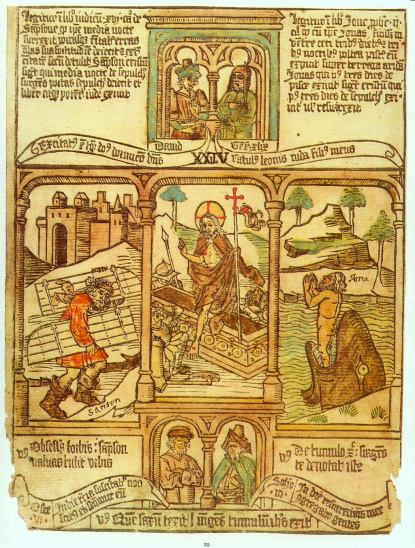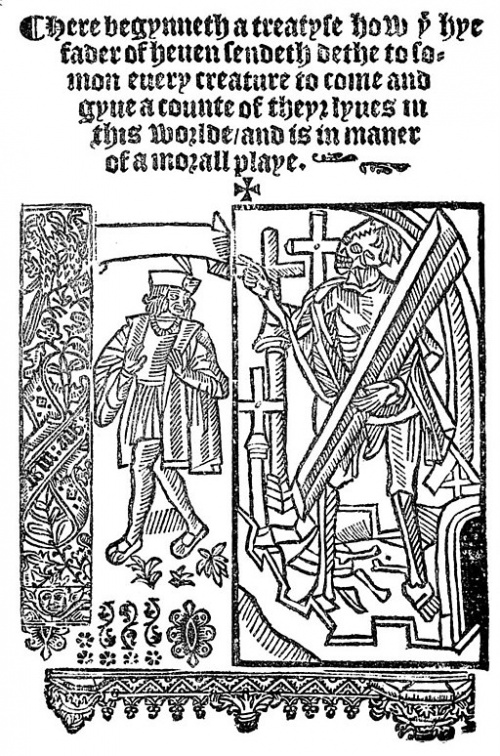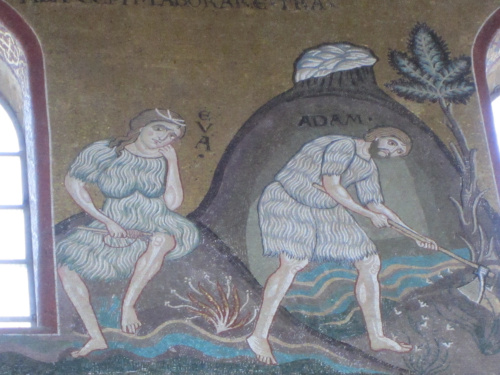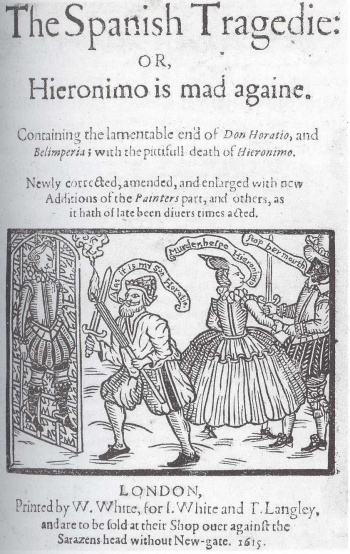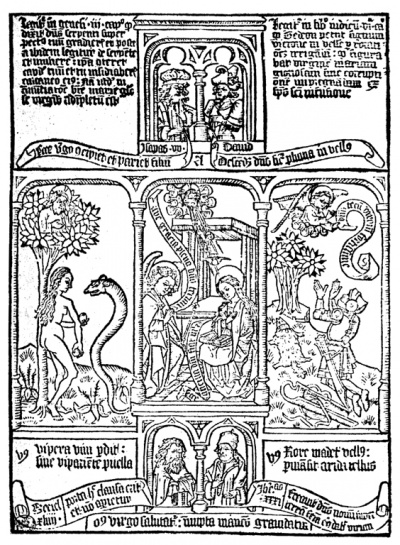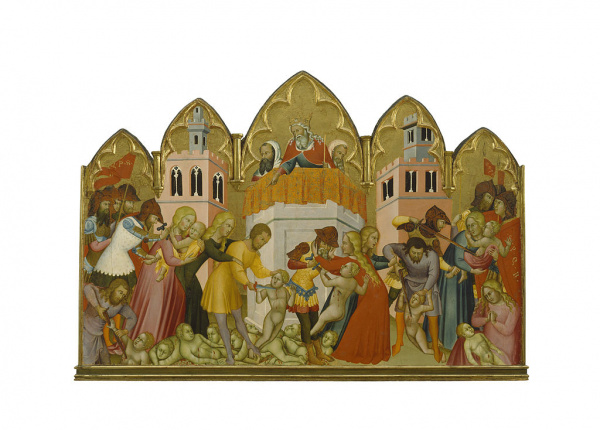Verba et Res/Words and Things: The Speaking Picture of Medieval Drama
This article is the first of three installments of the Ten Performance-Based Lesson Plans for Medieval Theatre, as noted in the article Medieval Drama and Performance-Based Pedagogy, conceived and written by Barbara J. Bono, Maria S. Horne, and Michelle Markey Butler, and is associated with the Folger Institute's 2016-2017 year-long colloquium on Teaching Medieval Drama and Performance, which welcomed advanced scholars whose research and pedagogical practice explore historical, literary, and theoretical dimensions of medieval drama from the perspective of performance.
As the title Verba et Res/Words and Things: The Speaking Picture of Medieval Drama suggests, this article focuses on a series of four performance-based lesson plans which build up from the rich relationship of word and thing in medieval drama.
While these Lesson Plans for Medieval Drama are designed as a sequence to support extended work, they may also be sampled and adapted strategically for shorter teaching units. Suitable for all kinds of students from the novice to the budding professional, they follow the format of the famous Folger Shakespeare Set Free teaching manuals, namely "What's On for Today and Why?," "What to Do?," and How'd It Go?" They offer some suggestions for how to capture the vitality of medieval drama in short time and limited space, and build on some of the best continuing scholarship in the field. They imply, as well, an on-going engagement in the developing interdisciplinary field of Performance Studies, which combines interest in the performing arts and literary theory with the fields of anthropology and sociology.
Continue on to Setting the Medieval Stage: Lesson Plans 5 through 7.
Continue on to Performing Medieval Drama: Audiences, Communities, and Adaptations: Lesson Plans 8 through 10.
Lesson Plans 1 through 4 for Medieval Drama and Performance-Based Pedagogy
In the Biblical account that underwrites medieval drama, God gave man the power of naming, and thus united words and things. But in the world we inhabit today, words are frequently separated from actions, and we are shy or disempowered, and read privately or do not know how to connect our words with what we do.
In order to move toward a fully embodied understanding and performance of the speaking picture that is medieval drama it can be helpful initially to separate its forceful but often seemingly unfamiliar language from its physical embodiment as images and things, to detach these words and things at first from their plots so as to familiarize them through defamiliarization before reintegrating them as performance.
Put simply, novice actors can speak, enjoy, and come to understand some words and phrases, or appreciate a concrete and symbolically-laden prop or a freeze-frame moment, as a preparation for integrating these words and things into a lively action.
Try some of these exercises with your students, and see how they will begin to become comfortable with some of the key words and things informing medieval drama, and begin as well to bond together into a company of players.
Lesson Plan 1: Playing around with medieval language
What’s On for Today and Why?
Middle English is fun to speak, fuller-throated and not all that much different from our own language, once you recognize a few different alphabetic and spelling variations and simply decide that you’re going to deliver it as though it were being acted or declaimed.
Here are some exercises which, when taken in conjunction with the excellent guidelines supplied in Medieval Drama and Language, can get your students started on voicing some key medieval words and phrases, initially as a game—the medieval ludens—apart from narrative or cultural context, but increasingly, through practice and discussion, ramifying into action and fuller meaning.
What to Do? Exercise A: Building and using the Medieval Insult and/or Compliment Game
Everyone knows the “Shakespeare Insult Sheet,” which has a long and vibrant history both in print and online and has been successfully commercialized as a book, the Shakespeare Insult Generator, and even as an app! In its classic form, you choose one insulting noun from Column C, combine it with two insulting adjectives from Columns A and B, hurl amiably at a classmate, and then tolerate the return: e.g. “Thou fawning, dirt-rotten codpiece” is returned as “Thou unhandsome, sheep-biting pig-nut.” A Compliment Sheet is similar, but not nearly as much fun.
But Shakespeare is hardly alone in plumbing the rich verbal traditions of invective and flattery, and you and your students can easily create a lexicon of insult or compliment for any medieval work or cluster of medieval works you plan to work on together.
Furthermore, doing so together, in conjunction with the historical/lexical resources of the Middle English Dictionary, can help you understand issues of meaning and action which will blossom as you continue to read and perform.
Below you will find two examples of such lists—one of insult and one of compliment—culled from the broad and outrageous morality play Mankind, where the genre’s personification and dramatization of virtuous and vicious behaviors creates a particularly rich lexical field for such a search.
Create such an insult and/or compliment sheet from the text(s) you are considering, either by yourself as teacher or as a classroom/homework assignment. In class, get your students up on their feet and in a circle, and practice putting together and hurling these insults at each other from side-to-side, and—tossing a ball or a stuffed animal as a prompt—across and around the circle.
After you’ve voiced the words for a while, discuss—if necessary looking them up—what they actually mean. Do we still use them today? Do they mean the same things then and now? Why would you speculate they have lived, changed, or died?
Alternatively, you can simply send your students on a word search for unusual or interesting words throughout the text that you are reading, compile those words into a list, and play the word-toss game, looking the words up and discussing their meaning as necessary.
How’d It Go?
In both versions of the word-toss game the goal is simply to get students curious about unfamiliar or unusual language, for now quite apart from context or meaning, and to get them to enjoy voicing these words to each other.
Students should get into the simple pleasure and power of directing the energy of sound and of language at each other, as a necessary prelude to interacting dramatically on stage and with an audience. They should savor the sound and force of these words, and become increasingly curious about their meaning.
If you like, you can accompany this exercise with a homework assignment to discover or create a similar insult and/or compliment sheet from another medieval work or from modern materials.
What to Do? Exercise B: Tossing lines
Take the word-toss game one step further by extracting and tossing brief and catchy lines from the work under consideration. On a set of cue cards write out (or have the students search and write out) a couple of dozen (depending on the size of your class perhaps as many as fifty) lines from the work, one per card, numbered by plot order.
Have the students form a circle and distribute the lines sequentially around it. Initially have them randomize the voicing of their lines by having them speak them out—“loudly and proudly”—each time a ball or a stuffed animal thrown across or around the circle reaches them.
Gradually encourage them to voice each other’s lines as they come to realize that they know them. If necessary, repeat with a second set of lines.
After the students seem comfortable with their individual lines, pass the ball or stuffed animal around the circle sequentially from the first to the final number one or two times, and explain that, whether they realize it or not, they now have a preparatory overview of the plot of the entire work.
Ask them to guess and query what the play seems to be about, and send them home to read it and be prepared for further enactment and discussion. Sample text from Everyman.
How’d It Go?
The students should by now not be shy about voicing some unfamiliar words and reacting to prompts from their classmates. They should have begun to look at and to listen to each other, to bond together in seriousness and silliness. They should be ready to encounter this language in a private reading experience and have begun to imagine or speculate about the type of characters and story with which they are about to become involved.
Lesson Plan 2: The twenty props you need to put on any medieval drama
What’s On for Today and Why?
The drama teacher’s best asset for spontaneous in-class performance is a prop bag. Go to the dollar store, the party store, Goodwill, or your own closet or garage (don’t spend more than $20-$50 dollars!) and assemble your own bag of inexpensive props which you judge, based on your reading of the texts, will be of use for putting on medieval and early modern plays.
No two prop bags will be the same, but we here include a list of twenty symbolically-suggestive props and some of the resonances they set up between the plays.
What to Do?
In class set this collection of props out on a long table.
Take out the play or anthology of plays you will be working with, and have the students read their titles around the room. Based solely on these titles, prompt them to answer or speculate what the plays are about, and what props might be useful for putting them on. (If they have limited ideas, prompt and elaborate a bit from your own knowledge of the plays.)
Divide the class into working groups of 3 to 5 students, assign each group a play, and invite them up to the front of the room to select those props which they think might be useful in staging their play.
Have them split up into different areas of the room to begin to block out as a tableau vivant (a snapshot living picture made from their posed bodies) what they think is a central moment in the action of their play, complete with the relevant props.
Have them reconvene as a group and show-and-tell each group’s tableau vivant.
How’d It Go?
The students should be intrigued, and should already begin to have some speculative sense (it’s OK for now if that sense is incorrect) of the possible action of each play and what it might look like. They should also have made a beginning in collaborating with—in playing creatively with—each other.
Have them go home and begin the first reading assignment.
Lesson Plan 3: Typology or medieval living history
What’s On for Today and Why?
Bring the prop bag to class again, and have it at the ready.
Acquaint your students with the basic theory of Biblical typology—that God “writes” the creation and events of human history and also provides a partial record of them in the Bible, where Old Testament events are held to prefigure New Testament ones as type to antitype.
Show how these correspondences organize much of the artistic representation in medieval ecclesiastical art, religious poetry, and biblical drama—particularly the pageants in the biblical “Creation” to “Last Judgement” cycles.
(So, for example, God’s willingness to save Noah and his family in the wooden Ark was seen as a type or prefiguration of Jesus’ willingness to save mankind on the wooden cross; or Abraham’s willingness to sacrifice his only son Isaac was seen as a type or prefiguration of God’s willingness to sacrifice his only son; or Gabriel’s Annunciation to Mary was seen as the reversal of the serpent’s temptation of Eve—Eva/Ave—or the dew of the Psalms was seen as a prefiguration or type of the Annunciation.)
What to Do?
Review the basic theory of Biblical typology and some of its key examples. (Chapter Four, “Corpus Christi Form: Principles of Selection,” in V.A. Kolve’s 1966 The Play Called Corpus Christi, pp. 57-100, and especially the diagram on page 85, offers the classic exposition of this theory.)
Show the students some major visual examples of this thinking, from the 12th through to the 16th centuries. Some visual examples of biblical typology.
How’d It Go?
Ideally the students should now have a sense of these religious stories as organized visually, and should be becoming more visually alert.
Have them go home and conclude a reading assignment that links a pageant from the Old Testament—for example a Noah or an Abraham and Isaac play with a New Testament play, for example, the Crucifixion.
Based on their reading to date, ask them also to sketch their own panel for a modern Biblia Pauperum, flanking a central image from a New Testament story with typological prefigurations from two Old Testament stories.
Alternatively, ask them to be typological illustrators of some aspect of their own personal history or of present-day events, flanking some event from their own lives or from the present day with what might be argued to be two typological prefigurations of it: for example, an image of their own pet bracketed by images of two previously-loved earlier family pets; or a picture from their own current living space bracketed by images of previous homes; or a picture of themselves bracketed by earlier family portraits; or an echoed historical or political event like presidential inaugurations or assassinations. What story/ stories do these linked images tell?
If these triptychs are effective, consider some way to make them continuously visible to the class as a whole--for example, as blown-up images or an online photo gallery--as an aid to further narrative building, as in the later lessons below.
Lesson Plan 4: Typology or medieval living history and tableau vivant
What’s On for Today and Why?
Bring the prop bag to class again, and have it at the ready.
Continue acquainting your students with the basic theory of Biblical typology—that God “writes” the creation and events of human history and also provides a partial record of them in the Bible—and move to showing how by developing some tableaux vivants to illustrate key typological turning points in the biblical cycle plays that they have read.
What to Do?
Have them read out loud and analyze several key lyric poems from the 12th through to the 16th centuries which illustrate typology, and imagine their possible analogues and application in some early English plays.
Now distribute brief texts from key turning points in a variety of cycle plays to working groups of four, five, or six students, where one student in each group will be the reader/chanter, one will be the sculptor, and the remaining students will be the blocks of marble which will form the characters in the tableaux vivants. While the chanter reads out the marked passage, the sculptor works on the bodies of the blocks of stone until she had a satisfying tableau vivant, a sculpted representation of a key typological moment. After the students have done this as groups, reconvene as a class and have each group show their tableau vivant—now with props added if they wish—to the class as a whole.
Take photographs of each tableau vivant, and post them around the room or in the course electronic archive to serve as a record and a kind of preliminary story-board for a more extensive possible production. Some possible moments to sculpt from the English biblical plays.
NB: This exercise can also be adapted to the episodes of any medieval play or set of plays.
How’d It Go?
With the first round of reading done, a formal and structural outline in place, some historical context provided, and a beginning awareness of the conjunction of words and things in medieval drama, students should be ready and eager for some selective re-reading and the move, in the next round of classes, to more dynamic acting of these plays.
Support materials for lesson plans 1 through 4
An insult and compliment sheet derived from the medieval morality play Mankind
Everyman and Mankind. Douglas Bruster and Eric Rasmussen. Methuen Drama, 2009.
Insults:
| Column A | Column B | Column C | |||
|---|---|---|---|---|---|
| Criminous | Obsequious | Beast | |||
| Culpable | Odible | Caitiff | |||
| Cunning | Perversious | Clerk | |||
| Cursed | Shrewd | Devil | |||
| Demonical | Sinful | Dunghill | |||
| Detestible | Stinking | Sinner | |||
| Dispectuous | Uncourteous | Transgressor | |||
| Inconsiderate | Unthrifty | Turd | |||
| Lecherous | Venomous | Wretch | |||
| Lewd | Wanton |
Compliments:
| Column A | Column B | Column C | |||
|---|---|---|---|---|---|
| Blessed | Precious | Lord | |||
| Courteous | Predilect | Master | |||
| Delectable | Preponent | Savior | |||
| Glorious | Seemly | Sovereign | |||
| Mellifluous | Steadfast | ||||
| Merry | Suavious |
Some arresting lines from the medieval morality play Everyman
Everyman and Mankind. Douglas Bruster and Eric Rasmussen. Methuen Drama, 2009.
- By figure a moral play.
- Man, in the beginning
- Look well and take good heed of the ending.
- Where art thou, Death, thou mighty messenger?
- Go thou to Everyman
- And show him, in my name,
- A pilgrimage he must on him take . . .
- Everyman, stand still! Whither art thou going
- Thus gaily? Hast thou thy maker forgot?
- A reckoning he will needs have
- Without any longer respite.
- Death, thou comest when I had thee least in mind!
- Thee availeth not to cry, weep and pray,
- But haste thee lightly that thou wert gone that journey,
- And prove thy friends if thou can.
- To whom were I best my complaint to make?
- What if I to Fellowship thereof spake . . .
- I will not go that loathsome journey.
- And yet, if thou wilt eat and drink and make good cheer
- Or haunt to women the lusty company,
- I would not forsake you while the day is clear.
- But an thou will murder any man or kill,
- In that will I help thee with a good will.
- To my kinsmen I will, truly,
- Praying then to help me in my necessity.
- I believe that they will do so,
- For kind will creep where it may not go.
- No, by our Lady, I have a cramp in my toe.
- Lo, fair words maketh fooles fain.
- Where art thou, my goods and riches?
- I lie here in corners, trussed and piled so high,
- And in chests I am locked so fast,
- Also sacked in bags.
- For it is said ever among
- That “Money maketh all right that is wrong.”
- My condition is man’s soul to kill,
- If I save one, a thousand I do spill.
- Marry, thou brought thyself in care,
- Whereof I am glad.
- I must needs laugh; I cannot be sad.
- Oh, to whom shall I make my moan
- For to go with me I that heavy journey?
- I go to my Good Deed.
- But alas, she is so weak
- That she can neither go nor speak.
- . . . I cannot stand, verily.
- [But] I have a sister that shall with you also,
- Called Knowledge . . .
- Now go we together lovingly
- To Confession, that cleansing river.
- Lo, this is Confession. Kneel down and ask mercy.
- And a precious jewel I will give thee
- Called penance, voider of adversity.
- Here shall you receive that scourge of me,
- Which is penance strong that ye must endure.
- I thank God, now I can walk and go,
- And am delivered of my sickness and woe.
- Put on this garment to thy behoof,
- Which is wet with thy tears . . . .
- Contrition it is.
- Thou must lead with thee
- Three persons of great might . . . .
- Discretion and Strength they hight,
- And thy Beauty may not abide behind.
- Also, ye must call to mind
- Your Five Wits for your counsellors.
- Go to Priesthood, I you advise,
- And receive of him in any wise
- The holy sacrament and ointment together.
- Alas, I am so faint I may not stand.
- My limbs under me do fold.
- What? Into this grave? Alas!
- Oh, all thing faileth, save God alone—
- Beauty, Strength and Discretion—
- For when Death bloweth his blast,
- They all run from me fast.
- All fleeth save Good Deeds, and that am I.
- Into thy hands, Lord, my soul I commend.
- Come excellent elect spouse, to Jesu . . . .
- Thy reckoning is crystal clear.
A list of 20 symbolically-suggestive props, and some of the resonances they set up in early plays
- A number of nimbuses or halos cut from golden cardboard or looped from golden rope for divine interventions such as creation, expulsion, annunciation, and saints and miracle plays
- Some crowns for kings and tyrants
- A set of inexpensive costume-store blank masks, some white, some black, to signify, problematize, and critique conflicts between “good” and “evil”
- A small decorated box, for secrets and gifts
- A scroll and a bound book, for letters, notes, and reading
- A hoe, for digging and delving
- A staff, for old age and as a weapon
- Some (bloody) fake daggers (we like the hollow plastic ones that bleed down when you tip them!) to maim and to kill
- In place of fake swords, some foam pool noodles cut in two for dueling and fights (you can advance to fake swords if you have some experience as a fight coach, but we prefer the pool noodles because they are safe, cheap, and funny—everyone enjoys mixing it up with them!)
- A knotted length of rope for whipping, tying up, and torture
- A couple of silly hats or caps for fools[
- A couple of cheap tankards for eating and drinking
- A couple of flat white sheets for ghosts, corpses, togas, etc., and for drawing symbolic maps with permanent marker on which to play or block your action
- A sky blue shawl for the Blessed Virgin Mary and other virtuous ladies (and consider some red ones for the not-so-virtuous)
- A figured scarf for a lady’s favor
- Some pairs of gloves to drop in flirtation or in knightly challenge
- A baby doll(s) and/or a/some fun stuffed animals, swaddled, to play around with
- A bottle of fake blood for all sorts of ghastly good reasons
- A couple of pieces of jewelry, like a gaudy ring, gold chain(s), a heart-shaped token, a cross, to serve as gifts, status signifiers, tokens of fidelity
- A skull or a death’s head, to remind us!
Some instructive examples that illustrate the enduring sacramental/symbolic resonances of these “things”
- The knotted rope has proved grimly useful for both Crucifixion plays and for stringing up Horatio in Thomas Kyd’s blockbuster The Spanish Tragedy
- The sky blue shawl has signified for Annunciation and Incarnation plays, but has also suggested the sacred dimensions of the sexual politics in Shakespeare’s Measure for Measure
- A child’s favorite stuffed hippo has just the shape to suggest Mary’s sudden miraculous baby bump at the Annunciation and to double for both the demon sheep baby and the swaddled Christ child in the Wakefield “Second Shepherds’ Play”
- The fools’ caps and ladies’ favors endure as signs of transience and folly from Everyman and Mankind to Shakespeare’s 1 Henry IV, Othello, and Ben Jonson’s city comedies
- The gloves can stand for other courtly favors and as chivalric gages, and find their absurdist climax in the inconclusive challenges that directly precede the deposition of the anointed king in Shakespeare’s Richard II, 4.1
- The skull grins over Everyman, and any number of memento mori moments in sixteenth- and early seventeenth- century drama, most famously the gravediggers’ scene (5.1) in Hamlet.
Some visual examples of biblical typology
In church art:
- The program of the late 12th-century mosaics—the central image of Christo Pantocratore, Christ the creator of all things, and the typologically-organized images which flow from it—at the Cathedral of Monreale in Sicily.
- Or the window program at King’s College, Cambridge.
In print:
- The iconographic program of the late 15th century block book The Biblia Pauperum (version of Princeton’s copy) with its triptych organization of a key New Testament event bracketed by two Old Testament typological anticipations and four prophecies of it.
Three typological poems and some dramatic applications
1,. Poem (Anonymous, 13th century)
- Nou goth sonne under wode
- Me reweth, Marie, thi faire rode.
- Nou goth soone under tree,
- Me reweth, Maria, thy sone and thee.
Application:
Medieval passion plays, but also Hieronimo’s paternal lament in Thomas Kyd’s c. 1584 The Spanish Tragedy: “But stay, what murd’rous spectacle is this?/ A man hang’d up and all the murd’rers gone!/ And in my bower, to lay the guilt on me!/ This place was made for pleasure, not for death.” (2.5)
2. Poem (Anonymous, 15th century)
- I syng of a mayden
- That is makeles,
- King of alle kings
- To here sone che chees.
- He cam also stille
- Ther his moder was
- As dew in Aprylle,
- That fallyt on the gras.
- He cam also stille
- To his modres bowr
- As dew in Aprylle,
- That falleth on the flowr.
- He cam also stille
- Ther his moder lay
- As dew in Aprylle,
- That falleth on the spray.
- Moder & mayden
- Was nevere noon but she:
- Well may swich a lady
- Godes moder be.
Application:
Medieval Annunciation plays, but also Portia’s speech in the court from William Shakespeare’s The Merchant of Venice: “The quality of mercy is not strained/ It droppeth as the gentle rain from heaven/ Upon the place beneath.” (4.1)
3. Poem (George Herbert, 1593-1633)
- Oh that I knew how all thy lights combine,
- And the configurations of their glory!
- Seeing not only how each verse doth shine,
- But all the constellations of the story.
- This verse marks that, and both do make a motion
- Unto a third, that ten leaves off doth lie:
- Then as dispersed herbs do watch a poition,
- These three make up some Christian's destiny:
- Such are thy secrets, which my life makes good,
- And comments on thee: for in ev'ry thing
- Thy words do find me out, and parallels bring,
- And in another make me understood.
- Stars are poor books, and oftentimes do miss:
- This book of stars lights to eternal bliss.
Application:
Early 16th century sonnet illustrating the entire theory of biblical theology in application to the believing Christian.
Some possible moments to sculpt from the English biblical play
- The (prat)fall of Lucifer
- The creation of Adam and Eve
- The snake tempting Adam and Eve
- The expulsion from Eden and bodily shame
- Cain slaying Abel with the chavel-bone
- Noah’s wife refusing to go into the Ark for the sake of her gossips
- Abraham, Isaac, and the Angel “holding” the stroke
- The Angel Gabriel announcing Mary’s pregnancy and Joseph troubled by it
- The revelation of Mak and Gil’s sheep demon baby and the nativity of Christ
- Herod raging on the pageant cart and in the street
- Herod’s soldier slaying the innocents and their mothers resisting them
- Jesus, the Pharisees, and the woman taken in adultery
- Christ stretched on the cross
- Jesus harrowing hell
- “Quem quaeritas”: The angel and the three women at Jesus’s tomb
- The judgement seat of Christ
Go to Medieval Drama and Performance-Based Pedagogy.
Continue on to Setting the Medieval Stage: Lesson Plans 5 through 7.
Continue on to Performing Medieval Drama: Audiences, Communities, and Adaptations: Lesson Plans 8 through 10.
Page written by
Barbara J. Bono, University at Buffalo, SUNY
Maria S. Horne, University at Buffalo, SUNY
Michelle Markey Butler, University of Maryland



